Menu
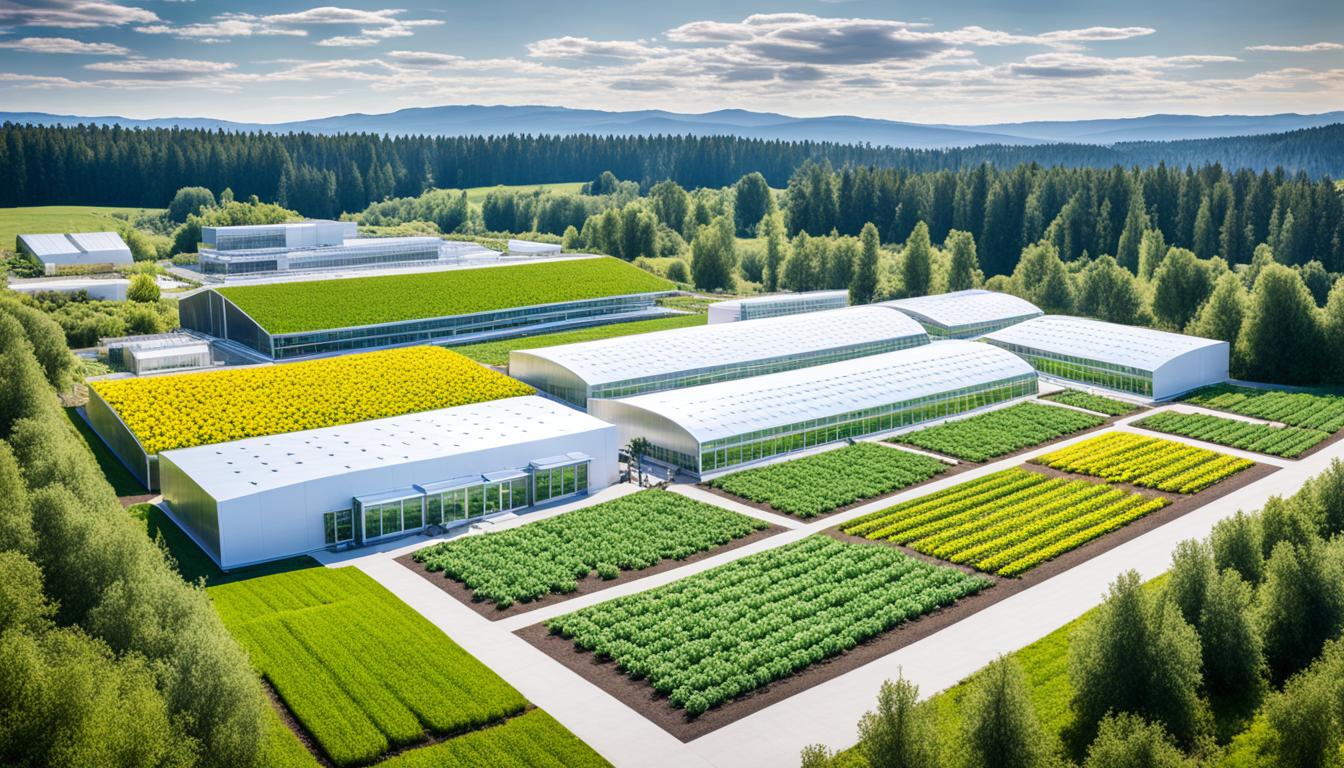
Agri Tech advances can increase crop yields by a massive 70%. This shows how powerful biotechnology farming can be in changing agriculture. In 2023, more publications started to look at managing plant genetic resources, making our food systems more sustainable, and improving how we breed crops.
Agricultural biotechnology is key to solving food security issues and battling climate change. With the UN pushing for these innovations in farming, we can meet the food needs of our growing world. These technologies not only make crops stronger and more abundant but also boost the food’s nutritional value. They play a vital role in creating a sustainable and thriving agricultural future.
Biotechnology farming is changing the face of modern agriculture. It uses complex techniques like genetic engineering and molecular diagnostics. It focuses on changing plants, animals, and microorganisms to make agriculture better and greener.
Biotechnology in farming uses scientific techniques to make crops stronger and more productive. This means changing the genes of plants so they produce more, are healthier to eat, and can fight off pests. For instance, some plants are made to be resistant to bugs, so farmers don’t need to use harmful chemicals as much. In the United States alone, in 2012, a high number of important crops had these genetic modifications, showing the significant role of biotechnology in agriculture.
The link between biotechnology and agriculture goes way back, to when people started farming. Big moments include the Green Revolution and the creation of GMOs. The Green Revolution gave us crops that produce a lot more and better farming methods. GMOs then changed how we think about growing crops.
Today, the USDA keeps detailed records of where biotech crops are grown. This helps us understand how these crops have become a big part of agriculture.
Now, using genetically engineered crops is becoming more and more common. Farmers grow these crops to increase their harvests and make food more nutritious, all while needing fewer chemicals. Regulators like the USDA, FDA, and EPA make sure these crops are safe for the environment and people. This careful scrutiny helps keep agriculture in the United States ahead on the world stage.
| Crop | Percentage Biotech Adoption (2012) |
|---|---|
| Corn | 88% |
| Cotton | 94% |
| Soybeans | 93% |
Genetic modification in farming has changed the game. It lets us change an organism’s DNA directly. This has made crop development much more precise. It also supports farming that’s kind to the planet.
GM crops grow more food and help the economy. The USDA says in 2012, most of the US corn, cotton, and soybeans were GM. They need less chemical pesticides. This helps the environment. Plants that resist weed killers can now use safer weed killers. These new herbicides don’t stick around to harm wildlife or us.

GM crops like insect-resistant cotton use less synthetic pesticides. They’re designing crops that can survive droughts and are more nutritious. This helps farms last longer and feed the world better.
Not everyone agrees about GM crops. Some worry about the genes spreading to wild plants. Others don’t like that companies can own these modified genes. And, many are unsure about eating GM foods long-term.
Experts and agencies like the USDA, EPA, and FDA check if GM crops are safe. They work hard to make sure these crops don’t harm us or our planet. Researchers warn we must keep an eye on GM crops growing where they shouldn’t. They say we should be careful with this technology.
Now, sustainable agriculture is growing with the help of new biotechnology. This tech tackles many eco and money issues. A key step is making biofertilisers and biopesticides. They cut down on chemical pesticides, not good for our world or health.
Farming that’s kind to the planet is a big deal. Biotechnology lets farmers use products that don’t harm ecosystems. Herbicide-tolerant crops are a good example. They let farmers use fewer harmful herbicides. This protects wildlife and people.
New farm tech is also cutting the need for pesticides. Genetically engineered cotton, for instance, needs less synthetic pesticides. This helps keep our water and land cleaner. Crops that resist glyphosate also mean less chemical use on farms.
Biotechnology is also great for the ground under our feet. It allows for growing crops in poor soil. By adding certain genes, these crops make the soil stronger over time. Microorganisms in this tech help plants grow, fight off bad bugs, and make the soil better.
All these biotech benefits show why it’s key for good farming. They help tackle big issues like climate change and the need for food. Embracing these innovations is crucial for future food and a balanced environment.
Precision farming technology is a key innovation in farming. It helps farmers make the most of resources and cut down waste. This approach uses high-tech tools for accurate crop production management.
Autonomous tractors and drones lower costs and boost yields. They make farming more efficient. ClimateAi’s predictive systems give vital regional and field insights for climate change. This helps farmers enhance crop production.
Automation in farming raises productivity. It also improves the careful use of land, water, and fertilisers. This is good for resources.
GPS guidance systems help farm machinery work precisely. They lessen waste in the fields. Real-time crop and soil tracking with remote sensing is crucial. It allows for instant health checks on crops.
Artificial intelligence and machine learning forecast weather and its effects on agriculture. This helps make smart choices. ClimateAi’s finance tools offer climate insights. They show how climate changes can impact farming.
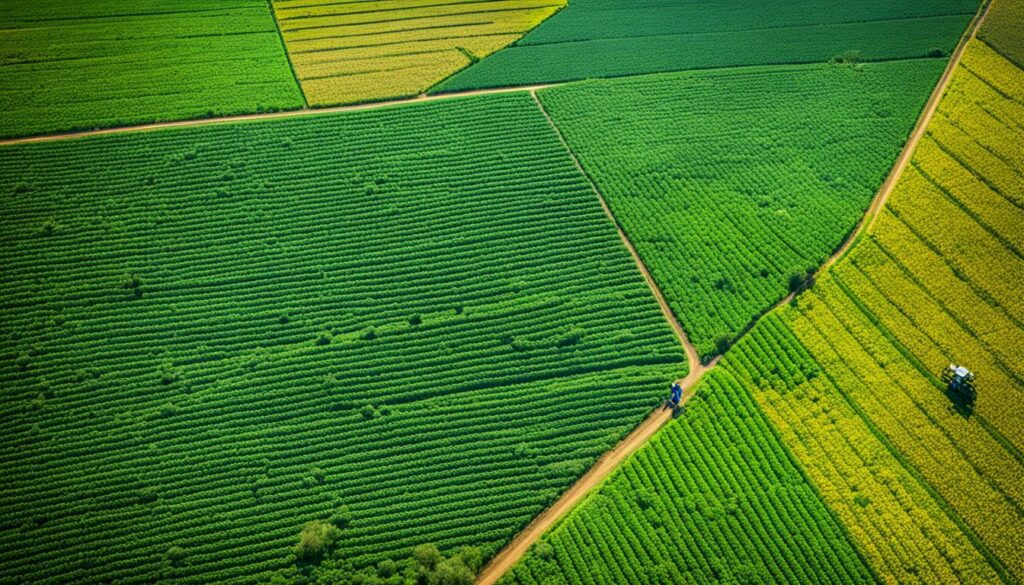
Case studies globally show the power of precision farming. Farmers with GPS-driven tractors see better crop yields and lower costs. ClimateAi’s tech helps prepare for weather events and future climate changes. It boosts crop endurance.
Agritech’s work on climate-resilient crops is key. It leads to crops that can handle various climates. This makes farming more sustainable and adaptable.
Genetic engineering is a key tool in bioengineering for better crops. It helps make crops more able to deal with climate change. Scientists change some genes to make crops that survive tough weather and fight off insects and diseases. This helps make farming more sustainable by using fewer chemicals.
In making crops that can survive without a lot of water, genetic engineering is a big help. Researchers edit the plant’s genes to use less water and keep growing even in dry spells. Maize and rice now grow better in dry areas. This work shows how genetic engineering can ensure enough food for everyone, even in tough conditions.
Genetic engineering also makes crops that can fight off bugs and diseases. Scientists add genes that make natural bug killers or boost the plant’s defence. Bt cotton and Bt corn stop bugs from ruining crops thanks to a special toxin. Using less bug spray helps the environment and keeps crops safe. In places where bugs and diseases harm crops a lot, genetically modified crops help keep the harvests good.
Adding genetic engineering to farming helps make the system stronger and more reliable. Making crops that stand strong against challenges shows the great power of genetic engineering in farming today.
Bioengineering for growing crops has brought great progress. It aims to tackle worldwide hunger and make farming more efficient. Scientists work to add vital nutrients to crops and make plants grow better.
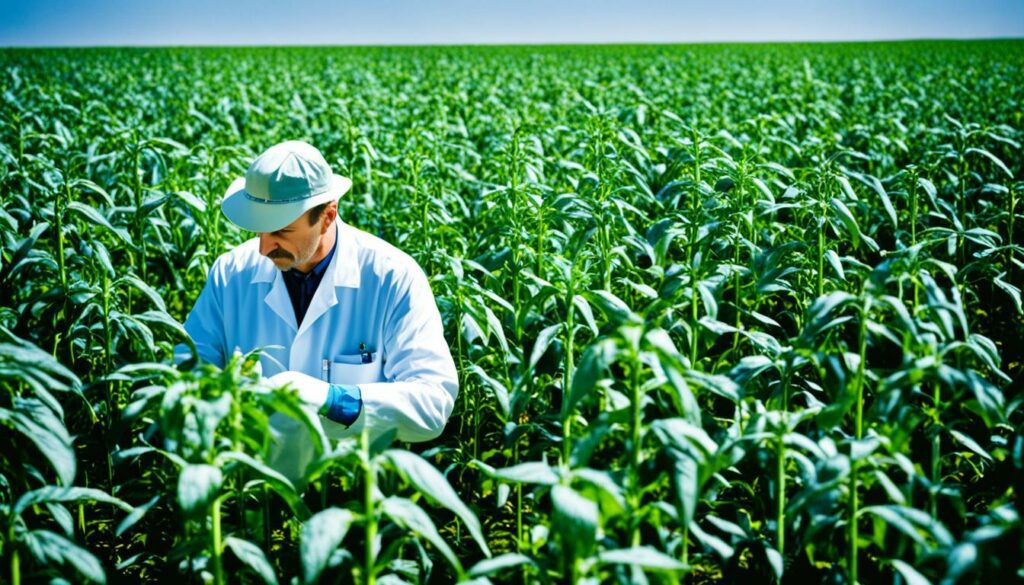
One key result is crops with better nutrition. For example, genetically modified rice has more beta-carotene to fight vitamin A lack. These crops help beat malnutrition. This is especially true in places where people don’t get enough nutrients.
This innovation is widely accepted, showing its big health benefits. ISAAA found that bioengineered crops are now common in many countries.
Bioengineering has made plant growth faster. With advanced genetics, plants grow quicker and breed sooner. This boosts food production. In the US, bioengineering is very popular, with most corn, cotton, and soybeans being bioengineered in 2012. The USDA shared this information.
This faster process means more food and a more secure food supply. It ensures that there are enough good crops all year round.
| Crop Type | Biotechnology Planting Percentage (2012) |
|---|---|
| Corn | 88% |
| Cotton | 94% |
| Soybeans | 93% |
In the last twenty years, we’ve focused more on making agriculture sustainable. This is due to our need for food and natural resources. It started with the United Nations Environment Programme in 1972. Actions like the UN Conference on Environment Development in 1992 pushed more global efforts. Mr. Subhash Palekar also played a big role, guiding 50 lakh farmers in India to use Zero Budget Natural Farming.
India’s biotech sector sees agricultural biotechnology as very important. A 2013 report by Business Standard highlighted its key role in society and the economy. With the gene revolution, biotechnology is set to change farming in big ways. It works by understanding gene sequences, making agriculture more productive.
Focus has turned to using *biofertilisers* and natural biopesticides. McNeely and Scherr (2001) suggested six farm-friendly methods, like saving biodiversity. These methods include using a mix of small organisms in biofertilisers. They show similar or better results than just using chemicals. This helps the soil and reduces the risks of using too many chemicals.
Also, using a certain type of biomass can be a natural *biopesticide*. This method boosts early plant growth. It’s good for the plants but also safe for the environment. Biopriming is seen as a way to improve farming without damaging nature.
Inoculating soils with beneficial microorganisms is proving very effective today. This method boosts both productivity and protects the environment. It’s part of using new technologies to grow more food but in a way that cares for our planet.
| Aspect | Details |
|---|---|
| Adoption | 50 lakh farmers adopting ZBNF |
| Technological Role | Indian biotech sector’s third largest segment |
| Gene Revolution | Expected to revolutionise biotechnological advancements |
| Biofertilisers | Microbial consortia, sustainable alternative to chemical fertilizers |
| Biopesticides | Algo-cyano-bacterial consortia, natural biopesticide solutions |
Biotechnology has the power to transform food security with new ways to grow food. It helps make farming more productive and improves the food we eat. This is crucial as the world deals with climate change and a growing population.
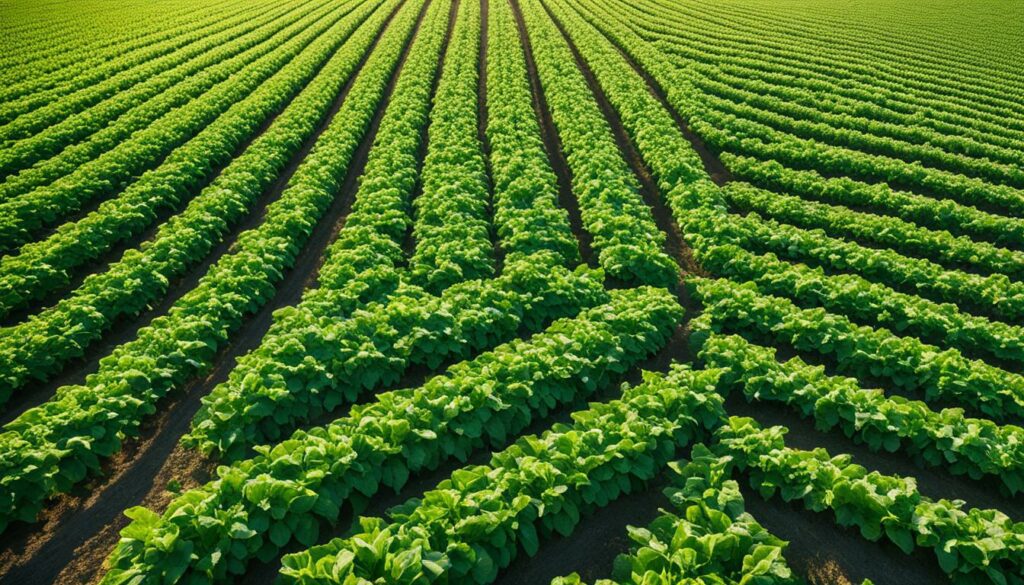
Biotechnology boosts how much food we can grow by creating special crops. These include GMOs, which have more nutrients and can survive tough conditions. Better crops mean more food that’s good for us, helping meet the needs of more people and saving natural resources.
The EU’s Farm to Fork Strategy highlights the importance of using less pesticides and choosing organic farming. It shows how these new farming methods are key to achieving big agricultural goals.
Biotechnology fights hunger worldwide, especially in tough climates. Take drought-resistant crops, for example; they are vital in dry areas. Scientists are also making food with more nutrients, meaning we’re getting better food more easily. This effort is part of the EU’s plan to protect land and seas for a healthier food future.
Lab-made citrus juice is also a look into the future. In California, scientists have made orange and lemon juice from tiny cell cultures. While it will be some time before these methods are common, it’s an exciting step in farming’s future.
| Strategy | Target | Progress | Deadline |
|---|---|---|---|
| European Green Deal | Climate-neutral by 2050 | Ongoing | 2050 |
| EU Farm to Fork | Reduce pesticides by 50% | Various stages | 2030 |
| EU Forest Strategy | Plant 3 billion trees | 0.14% as of June 2022 | 2030 |
| Food Loss and Waste | Minimise 31% waste | 14% lost, 17% wasted | Ongoing |
Biotechnology faces many challenges and ethical issues. There is concern over changing animals and plants genetically. This has led to debates about animal welfare and ethical problems.
Cloning animals or plants, for different purposes, has also raised ethical questions. People discuss where the moral limits should be.
“The Council of Europe Parliamentary Assembly recommended the inclusion of ethical considerations centred on humankind, society, and the environment in deliberations regarding developments and applications in biotechnology,” — Council of Europe (2000).
Regulations are crucial for the safe development and use of biotechnology. They ensure that genetically modified items don’t harm people or nature. Many genetically changed animals are still being studied, awaiting their safe commercial use.
The UK’s Royal Society stresses the importance of discussing the ethics and science of genetically modified food. It suggests public debate is key.
Some farm animals have been changed to be more efficient, nutritious, or resistant to diseases. The EnviropigTM is one example, aiming to lessen farm pollution. Strong regulations are necessary for checking these developments’ effects and keeping the public safe.
What the public thinks greatly influences how well new biotechnological items are accepted. Genetically modified foods, for example, have not been widely welcomed. This is because many people have ethical concerns about them.
Islamic scholars have debated the use of biotechnology in food and issued rulings. The Malaysian Islamic authority, for instance, says some genetically modified foods are not allowed for Muslims. Pope John Paul II stressed the need for careful consideration when using biotechnology in agriculture, focusing on science and ethics over quick profit.
It’s essential to talk openly with the public about biotechnology. This can help address their worries and correct any misunderstandings. Educating people about genetically modified items and involving them in discussions can help create a more informed and open-minded society.
| Consideration | Example |
|---|---|
| Animal Welfare | Increased ethical issues due to animal genetic engineering |
| Public Health | Concerns on long-term health effects of GM foods |
| Environmental Impact | EnviropigTM reducing agricultural pollution |
| Religious Views | Restrictions on GM foods with pig DNA for Muslims |
To solve agriculture’s biotech challenges, we need to mix ethics and regulations. Open discussions and clear rules ensure innovation is safe, ethical, and welcomed by all.
Biotechnology has really changed farming. It gives us better crops and helps our planet too. It’s clear when we look at examples from around the world.
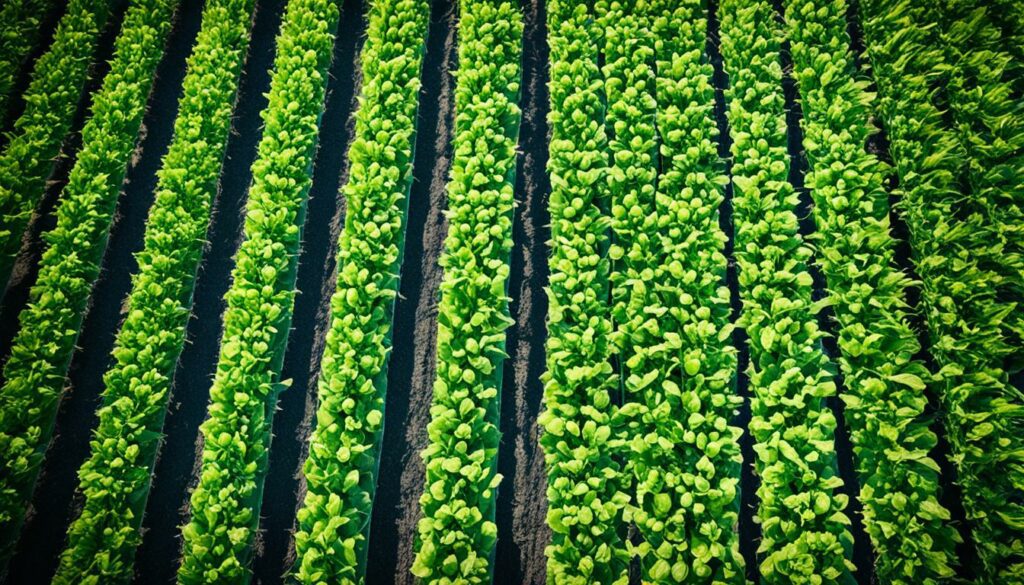
In 2012, the U.S. saw lots of biotech crops like corn, cotton, and soybeans. Most of them were genetically modified. For example, cotton that can resist bugs means fewer pesticides are needed. This is good for both the environment and the farmers. Also, papayas in the U.S. have gotten a boost from being able to fight off a disease thanks to genetic engineering.
On a global scale, many countries use a lot of biotech crops too. The ISAAA found that these crops cover a big area. This shows how important they are in today’s farming. Plus, U.S. agencies like the NASS, FDA, and EPA make sure these crops are safe and work well. This is to protect both people and the environment.
Biotech in farming has brought some big benefits. Crops are now of better quality and yield more. By using biotechnology, farmers can control weeds better without using many pesticides. For example, corn and soybeans that can resist diseases and bugs are popular in the U.S. This is because they need fewer pesticides.
Studies show biotech has helped the economy and the environment a lot. Thanks to things like special fertilisers and pesticides, farm soil is healthier and there are less harmful chemicals around. About 80% of processed foods have something from biotech in them. This shows how much people trust and rely on these technologies.
To wrap up, biotech has a big role in making farming more sustainable and feeding the world. It makes things easier and safer for farmers. And it makes our food better and safer, thanks to checks by the USDA, EPA, and FDA.
The future of agricultural biotechnology is full of promise. We are exploring new frontiers. Advanced biotech technologies are set to transform the industry. They bring innovations that could change how we farm globally.
Exciting new biotech fields include gene editing, synthetic biology, and microbial biotechnology. Gene editing lets us tweak crops so they fight diseases and cope better with the environment. Synthetic biology creates new bio-based solutions to help crops grow. And microbial biotechnology uses good microbes to improve the health of the soil and plants.
Agricultural biotech may see big changes soon. Making crops that can withstand herbicides is one advance. It could cut down on using harmful chemicals, especially in Africa and South Asia. No-till farming, though facing some early hurdles, is a breakthrough for small farms, making them more sustainable.
Working on crops like cassava and yams can also help feed people in poorer countries. But, making these advancements reachable for small farmers is key. Leaders in developing nations have to juggle research needs and budget limits. Also, it’s vital to ensure people’s needs come before just making a profit.
| Technology | Potential Impact | Challenges |
|---|---|---|
| Gene Editing | Enhanced crop resistance and productivity | Ethical concerns, regulatory complexities |
| No-Till Farming | Improves soil health and reduces erosion | Adaptability issues, initial cost |
| Orphan Crops | Increased food security in developing countries | Market acceptance, research funding |
| Synthetic Biology | Creation of new crop traits | Technological complexity, public perception |
The future of agricultural biotechnology depends on tackling these issues. It also relies on the excitement of new technologies. By focusing on innovation with sustainability, agriculture can make great strides forward.
The environmental perks of using biotechnology in farming are huge. They help reduce our carbon footprint. This means less harm to our planet. Farming techniques like these use land more efficiently. This helps to keep forests from being cut down. It also protects the places where wild animals live.
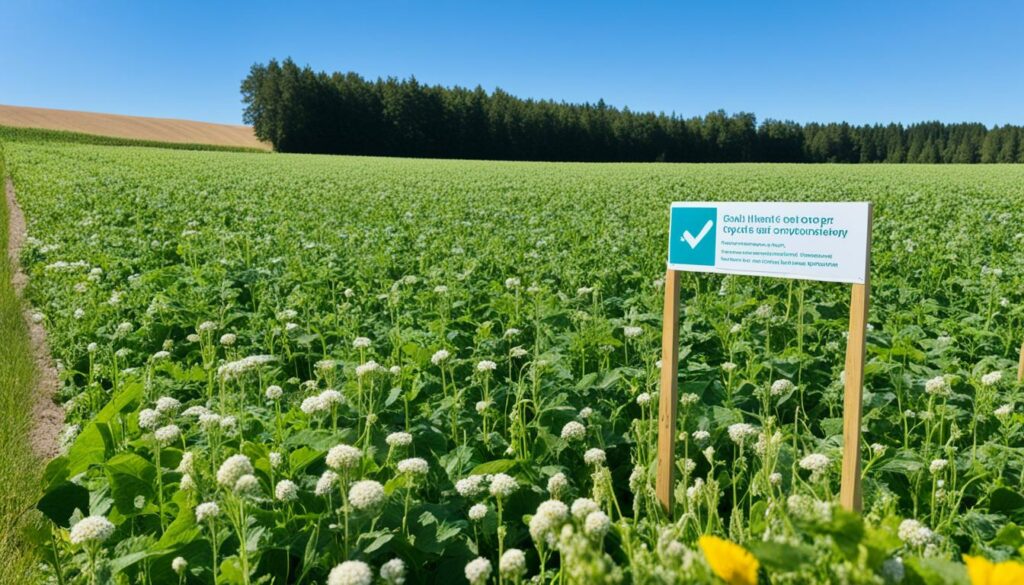
One big environmental benefit of biotechnology is cutting down on carbon footprint. In 2007, less plowing thanks to biotechnology cut out 31.2 billion pounds of CO2. That’s like not having 6.3 million cars poofing up the air for a year. In the same year, herbicide-tolerant crops in the US alone saved 9.48 billion pounds of CO2. This was like keeping 1.9 million cars parked.
Science has also made plants that don’t need as much water to survive. Add on better ways of watering plants, and we save a lot of water. Less water use means less stress on our water supplies. Using these special crops means we don’t need as many things to grow them. This keeps water in the earth where it’s needed while still growing lots of food.
| Benefit | Data |
|---|---|
| Reduction in pesticide use (1996-2007) | 790 million pounds |
| Adoption of GE soybeans, US (2009) | 91% |
| Reduction of carbon dioxide by HT crops (2007) | 9.48 billion pounds |
| Decrease in environmental impact (EIQ) | 18.4% |
Biotechnology’s effects are big, and they stick around for a long time. They’re crucial for feeding more people without hurting the planet. All these benefits show why biotechnology is important for our fight against climate change. They help us use less and grow more, which is great news for our world.
The future of farming includes biotechnology and its big economic impacts. Biotechnological methods have not just upped the game in productivity. They’ve also brought big savings to farmers.
Thanks to biotechnology, we use fewer synthetic pesticides today. Genetically modified insect-resistant crops, like cotton, have helped. This means farms spend less on pesticides and do less harm to the environment. Biotech has also upped crop quality and yield. This makes farmers’ jobs easier and their profits bigger.
In the United States in 2012, most corn, cotton, and soybeans came from biotechnology. This info from the USDA shows how widely it’s used and its cost savings. By using GMOs, farmers get more without spending more. This means farming costs less overall.
There’s a growing global market for biotech products. In 2012, the area of biotech crops worldwide expanded a lot. This shows a big demand for better food and farming. Tech startups are also making the sector more innovative.
The USDA, EPA, and FDA work together to test the safety of biotech crops. This makes consumers trust these products more. So, there are big chances in the market as people look for safer, more nutritious food.
| Region | Key Crops | Adoption Rate | Economic Impact |
|---|---|---|---|
| United States | Corn, Cotton, Soybeans | 88%, 94%, 93% | Cost Efficiency, Reduced Pesticide Use |
| Brazil | Soybeans | High Adoption | Lower Production Costs (USDA GAIN report) |
| China and South Africa | Bt Cotton | Widespread | Enhanced Farmer Profitability |
Farming with biotechnology is always growing. It will keep developing, making farming more profitable and good for the environment.
People view biotechnology farming in different ways. Some see benefits like better food security and a cleaner environment. Yet, others worry about the ethics and health problems it might cause.
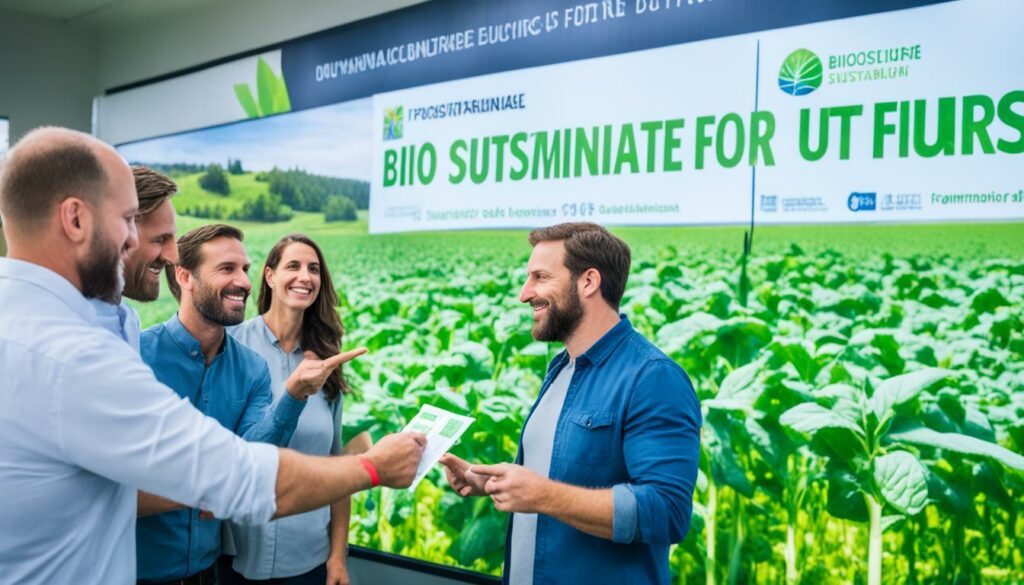
In the world of business, the view on biotechnology farming is positive. Companies, researchers, and policy makers support its innovative nature. They believe it can change farming for the better and help solve global issues. They also think it’s key for crops to be stronger, which can help with food security.
The USDA, EPA, and FDA check on genetically engineered crops. They look at their features and risks to keep us safe and protect the environment. This helps everyone understand biotechnology better.
Let’s look deeper into how biotechnology is used in farming:
| Crop | Percentage Planted Using Biotechnology (2012) |
|---|---|
| Corn | 88% |
| Cotton | 94% |
| Soybeans | 93% |
Seeing how much corn, cotton, and soybeans use biotechnology shows it’s well-liked and effective. The USDA’s NASS shows these trends.
It’s important to keep talking about biotechnology farming. This helps with its growth, rules, and general approval. With good talks, both communities and businesses can reach better food security and greener farming.
Today, our farming sector is changing fast. Teaching the next generation about agricultural biotechnology is key. These courses help students learn the skills to make farming more innovative and sustainable.
The On The Farm STEM project, backed by the Beef Checkoff, is a great example. It gives STEM lessons with a focus on beef to students from middle school to high school. This way, they learn about how different parts of the ecosystem work together.
The FDA, EPA, and USDA’s Agricultural Biotechnology Education and Outreach Initiative aims to teach people about this field. The FDA offers the Science and Our Food Supply course for students in middle and high school. This helps them understand agricultural biotechnology better.
Around 20,600 experts in agriculture and science have Ph.D. degrees in the U.S. Nearly 15% focus on teaching. This shows the huge importance of good agricultural biotechnology education. Such education helps students prepare for many jobs in the field.
In February 2021, the FDA launched an online course on genetically modified plants. This focuses on genetic editing to make GMOs. It’s a big step in making this education available to more people.
Teaching about agricultural biotechnology is not just for school. It’s a way to invest in farming’s future. With global issues like climate change and not enough food facing us, training in this area is crucial. Good education in this field will lead to better farming for the future.
Biotechnology in farming is key to solving issues like feeding the world and being sustainable. We’ve looked at its benefits and how it impacts people and the world. But, in Africa and South Asia, slow use of new crops shows we need more local-friendly types.
In places like India, where many can work in the fields, there’s a choice to make. They can use new crops that need less work but might reduce jobs. The cost of special seeds is a big hurdle for small farmers. Making new types of food that are rich in nutrients but cost more is important. This can help farmers and people who buy the food. Countries need to work together. They should listen to experts to plan future research well.
The push for biotechnology often comes from companies. They look at what sells, not just what farmers or governments need. This can lead to problems like not testing products enough before selling them. Even though a lot of our food already has biotech stuff, safety and good farming practices are still most important.
Looking ahead, biotechnology has a big job in farming. It can help control pests, make crops stronger, and boost our food supply. This is very important with more people needing food but the current way we grow crops not keeping up. Innovation in biotechnology is a must. It will help us farm better while caring for the environment. This balance is key for our future.
Biotechnology in farming uses advanced methods to change the characteristics of plants and animals. It includes things like genetic engineering and molecular markers. The goal is to make agriculture more productive and long-lasting.
Since ancient times, farming has used biotechnology. Events like the Green Revolution and the arrival of GMOs have marked major milestones. These have deeply influenced today’s farming methods.
Today, farmers are increasingly using GMO crops. These crops are designed to grow better, fight off diseases and pests, and be more nutritious. This shift is making agriculture more effective and sustainable.
GMO crops bring several benefits. They boost harvests, lower the need for harmful pesticides, and withstand tough conditions like drought. These advantages help agriculture progress in a more sustainable way.
There are worries about GMOs. These include their effect on the environment, who owns the rights to these altered genes, and the possible long-term health impacts. Governments and scientists are working to address these concerns.
Biotechnology aids in creating eco-friendly farming methods. For example, using biofertilisers and biopesticides can improve crop health without the need for as many chemical pesticides. This supports a more sustainable kind of farming.
By offering biological alternatives to harsh chemical pesticides, biotechnology helps cut down pesticide use. This move is eco-friendly and promotes a healthier planet.
Biotechnology helps by creating crops that can grow well in poor soils. This means the soil stays healthier, supporting the growth of more food and making farming more sustainable.
Precision farming uses modern technologies like GPS, machines that work by themselves, and devices that take data from afar. These all help farmers do their work in a more careful and efficient way.
Studies show that using precision farming can boost the amount and quality of crops. It can also make farming more eco-friendly and help farm lands last longer.
Genetic engineering makes plants able to tough out droughts and fight off pests and diseases. This resilience means crops can survive bad conditions without needing as many chemicals.
Bioengineering makes crops packed with more essential nutrients. This can help fight off hunger and malnutrition, especially in places where food is scarce.
Biofertilisers and biopesticides are made from biological materials. They help keep crops strong and healthy without the downsides of using too many chemical inputs. This is good for the environment and for the people who eat the food.
By making crops grow better and more nutritious, biotechnology plays a big part in making sure there’s enough food for everyone. It helps farming withstand the challenges the environment throws at it, too.
Some big topics are the ethics of changing genes and who can control these new biological creations. Plus, ensuring these new technologies are safe and benefit everyone is key. The way the public sees these issues affects how well these products do in the market.
Globally, we see success in fields like genetically improved crops and the use of friendly bacteria for farming. These technologies lead to more food, better environmental practices, and support for farmers all over the world.
Cutting-edge ideas like gene editing and synthetic biology are the future of farming. They aim to make agriculture more effective and sustainable, supporting a better planet for us all.
Biotechnology helps agriculture be more planet-friendly in many ways. Less chemicals, water, and energy are needed, which cuts down on pollution and waste. This is great for the environment.
It brings many good changes, including saved costs for farmers, a growing market for biotech products, and new opportunities in tech and farming companies. This improves the economy and helps keep agriculture friendly to the earth.
People’s views on biotech farming vary. Some see it as a way to make more food and help the environment, while others worry about its effects on people and ethics. Those in the farming and tech industries think it’s a powerful way to deal with global farming challenges.
Teaching young people about biotech farming is crucial for moving the sector forward. It gives them the knowledge and skills to create farming that’s good for the earth and everyone living on it, ensuring a lasting and good future for farming.